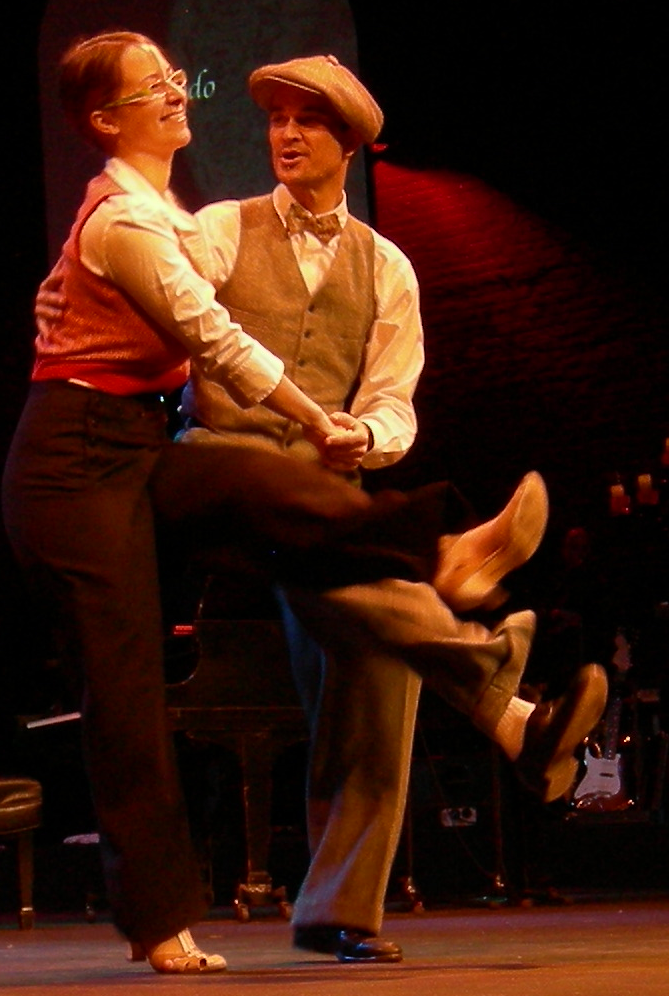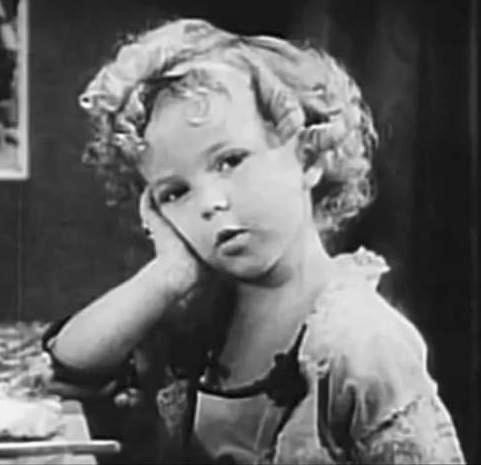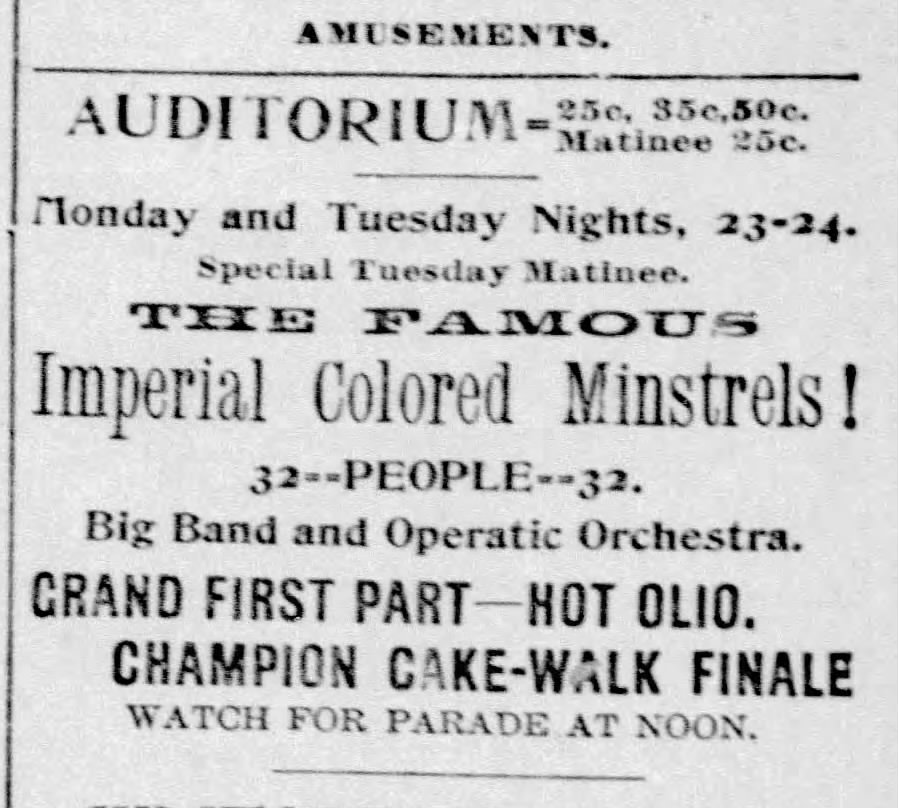|
Tap Dance
Tap dance (or tap) is a form of dance that uses the sounds of tap shoes striking the floor as a form of percussion; it is often accompanied by music. Tap dancing can also be performed with no musical accompaniment; the sound of the taps is its own music. It is an American artform that evolved alongside the advent of jazz music. Tap is a type of step dance that began with the combination of Southern American and Irish dance traditions, such as Irish soft-shoe and hard-shoe step dances, and a variety of both slave and freeman step dances. The fusion of African rhythms and performance styles with European techniques of footwork led to the creation of tap dance. This fusion began in the mid-17th century but did not become popular until the mid-19th century. There are two major versions of tap dance: rhythm (jazz) tap and Broadway tap. Broadway tap focuses on dance; it is widely performed in musical theater. Rhythm tap focuses on musicality, and practitioners consider themselve ... [...More Info...] [...Related Items...] OR: [Wikipedia] [Google] [Baidu] |
Clog Dancing
Clog dancing is a form of step dance characterised by the wearing of inflexible, Clog (British), wooden soled clogs. Clog dancing developed into differing intricate forms both in Wales and also in the North of England. Welsh clog dancing mainly originates from various slate mines where workers would compete against each other during work breaks. Northern English traditional clog dancing originates from Lancashire, Yorkshire, County Durham, Northumberland and the Lake District. Welsh and English clogs, with leather uppers and a sole cut from alder or sycamore were the regular, everyday footwear for working people all over Britain until the 1920s. Dancing clogs are close fitting which allows the dancer more control over the movements of their feet. English clogs with an iron or rubber protective layer on the sole are also worn for Morris dance#North West, North West morris. The main focus of a step dancer is in the footwork: dancers can create many different types of sound using ... [...More Info...] [...Related Items...] OR: [Wikipedia] [Google] [Baidu] |
Arthur Duncan
Arthur Chester Duncan (September 25, 1925 – January 4, 2023) was an American tap dancer, also called an "Entertainer's Entertainer,"“About the International Tap Dance Hall of Fame: Biographies,” American Tap Dance Foundation, accessed April 27, 2022. known for his stint as a performer on ''The Lawrence Welk Show'' from 1964 to 1982. This, along with his earlier inclusion (despite objections) on '' The Betty White Show'' in 1954 and with the help of White herself, made him the first African-American regular on a variety television program. He performed all over the world, and notably at Lincoln Center and Carnegie Hall. Early life Born in Pasadena, California, one of thirteen children, Duncan entered show business at age thirteen, when he was a member of a dance quartet that performed at McKinley Junior High School in Pasadena. He later entered Pasadena City College to study pharmacy. Career Arthur Duncan took dance lessons with Willie Covan and Nick Castle. Duncan claim ... [...More Info...] [...Related Items...] OR: [Wikipedia] [Google] [Baidu] |
Jazz Dance
Jazz Dance is a performance dance and style that arose in the United States in the early 20th century. Jazz Dance may allude to vernacular Jazz, Broadway or dramatic Jazz. The two types expand on African American vernacular styles of dance that arose with Jazz Music. Vernacular dance refers to dance forms that emerge from everyday life and cultural practices of a specific community, often reflecting the social, cultural, and historical contexts of that community. In the context of African American culture, vernacular dance encompasses styles that developed organically within African American communities, influenced by African traditions, European dance forms, and the unique experiences of African Americans in the United States. Vernacular Jazz Dance incorporates ragtime moves, Charleston, Lindy hop and mambo. Popular vernacular Jazz Dance performers include The Whitman Sisters, Florence Mills, Ethel Waters, Al Minns and Leon James, Frankie Manning, Norma Miller, Dawn Ha ... [...More Info...] [...Related Items...] OR: [Wikipedia] [Google] [Baidu] |
Lindy Hop
The Lindy Hop is an American dance which was born in the African-American communities of Harlem, New York City, in 1928 and has evolved since then. It was very popular during the swing era of the late 1930s and early 1940s. Lindy is a fusion of many dances that preceded it or were popular during its development but is mainly based on jazz dance, jazz, tap dance, tap, breakaway (dance), breakaway, and Charleston (dance), Charleston. It is frequently described as a jazz dance and is a member of the swing (dance), swing dance family. In its development, the Lindy Hop combined elements of both partnered and solo dancing by using the movements and improvisation of African-American dances along with the formal eight-count structure of European partner dances – most clearly illustrated in the Lindy's defining move, the swingout. In this step's open position, each dancer is generally connected hand-to-hand; in its closed position, leads and follows are connected as though in an e ... [...More Info...] [...Related Items...] OR: [Wikipedia] [Google] [Baidu] |
Nicholas Brothers
The Nicholas Brothers were an entertainment act composed of brothers, Fayard (1914–2006) and Harold (1921–2000), who excelled in a variety of dance techniques, primarily between the 1930s and 1950s. Best known for their unique interpretation of a highly acrobatic technique known as " flash dancing", they were also considered by many to be the greatest tap dancers of their day, if not all time. Their virtuoso performance in the musical number "Jumping' Jive" (with Cab Calloway and his orchestra) featured in the 1943 movie '' Stormy Weather'' has been praised as one of the greatest dance routines ever captured on film. Growing up surrounded by vaudeville acts as children, they became stars of the jazz circuit during the Harlem Renaissance and performed on stage, film, and television well into the 2000s. Diminutive in size, they were appreciated for their artistry, innovation, and soaring leaps. Early lives Fayard Antonio Nicholas was born August 28, 1914, in Mobile, Alabama, ... [...More Info...] [...Related Items...] OR: [Wikipedia] [Google] [Baidu] |
Shirley Temple
Shirley Temple Black (born Shirley Jane Temple; April 23, 1928 – February 10, 2014) was an American actress, singer, dancer, and diplomat, who was Hollywood's number-one box-office draw as a child actress from 1934 to 1938. Later, she was named United States Ambassador to Ghana and United States Ambassador to Czechoslovakia, Czechoslovakia, and also served as Chief of Protocol of the United States. Temple began her film career in 1931 when she was three years old and became well-known for her performance in ''Bright Eyes (1934 film), Bright Eyes'', released in 1934. She won a special Academy Juvenile Award, Juvenile Academy Award in February 1935 for her outstanding contribution as a juvenile performer in motion pictures during 1934 and continued to appear in popular films through the remainder of the 1930s, although her subsequent films became less popular as she grew older. She appeared in her last film, ''A Kiss for Corliss'', in 1949.Windeler 26 She began her diplomatic ... [...More Info...] [...Related Items...] OR: [Wikipedia] [Google] [Baidu] |
Buck-and-wing
Black Vaudeville is a term that specifically describes Vaudeville-era African American entertainers and the milieus of dance, music, and theatrical performances they created. Spanning the years between the 1880s and early 1930s, these acts not only brought elements and influences unique to American black culture directly to African Americans but ultimately spread them beyond to both white American society and Europe. Vaudeville had what were known as "circuits", venues that booked touring entertainers. Racism made it difficult for a black performer to be accepted into the white circuits of the day, though some performers had crossover appeal. The Theater Owners Booking Association (TOBA) was created for Black performers to get steady bookings in theaters that served Black audiences. Eventually, TOBA was replaced in the 1930s by " chitlin' circuits", which emerged to link black performers and entertainment opportunities. Background American Vaudeville began in the early 1880s, a ... [...More Info...] [...Related Items...] OR: [Wikipedia] [Google] [Baidu] |
The Whitman Sisters
The Whitman Sisters were four African-American sisters who were stars of Black Vaudeville. They ran their own performing touring company for over forty years from 1900 to 1943, becoming the longest-running and best-paid act on the T.O.B.A. circuit. They comprised Mabel (May) (b. Ohio; 1880–1942), Essie (Essie Barbara Whitman; b. Osceola, Arkansas, July 4, 1882 – May 7, 1963), Alberta "Bert" (b. Kansas; 1887–1964) and Alice (b. Georgia; 1900–December 29, 1968). History The sisters were the daughters of Reverend Albery Allson Whitman and Caddie Whitman (), who lived in Ohio, Arkansas and Kansas before settling in Atlanta, Georgia. The sisters had an older brother, Caswell (1876–1936). Reverend A. A. Whitman came to be known as the "Poet Laureate of the Negro Race". The sisters were taught by their father to sing religious songs and to dance, in order to accompany him on evangelical tours. Around 1899, Mabel and Essie began performing as the Danzette Sisters (or "Dazn ... [...More Info...] [...Related Items...] OR: [Wikipedia] [Google] [Baidu] |
Alice Whitman
"Baby" Alice Whitman (1900–1968) was an African-American tap dancer and the youngest member of the Whitman Sisters ensemble. Known as the "Queen of Tap", she was considered the troupe's star dancer and was known as the finest woman tap dancer of the 1920s–30s. Biography Alice Whitman was born in Atlanta, Georgia, the youngest daughter of Caddie and Reverend Albery Allson Whitman. Alice was significantly younger than her sisters, and according to some accounts, was adopted. Alice's father Reverend Whitman was born into slavery, but at the time of Alice's birth was a prominent black poet and writer. He would become known as the "Poet Laureate of the Negro Race" and served as Bishop of the African Methodist Episcopal Church in Lawrence, Kansas. Alice was born while her father was serving as Dean of Morris Brown College in Atlanta. Reverend Whitman died in 1901, when Alice was only a year old. The Whitman Sisters In 1899, the year before Alice's birth, Whitman's older sist ... [...More Info...] [...Related Items...] OR: [Wikipedia] [Google] [Baidu] |
Bill Robinson
Bill "Bojangles" Robinson (born Luther Robinson; May 25, 1878 – November 25, 1949), was an American tap dancer, actor, and singer, the best known and the most highly paid black entertainer in the United States during the first half of the 20th century. His long career mirrored changes in American entertainment tastes and technology. His career began in the age of minstrel shows and moved to vaudeville, Broadway theatre, the recording industry, Hollywood films, radio, and television. According to dance critic Marshall Stearns, "Robinson's contribution to tap dance is exact and specific. He brought it on its toes, dancing upright and swinging," adding a "hitherto-unknown lightness and presence." His signature routine was the stair dance, in which he would tap up and down a set of stairs in a rhythmically complex sequence of steps, a routine that he unsuccessfully attempted to patent. He is also credited with having popularized the word ''copacetic'' through his repeated use of ... [...More Info...] [...Related Items...] OR: [Wikipedia] [Google] [Baidu] |
John W
John is a common English name and surname: * John (given name) * John (surname) John may also refer to: New Testament Works * Gospel of John, a title often shortened to John * First Epistle of John, often shortened to 1 John * Second Epistle of John, often shortened to 2 John * Third Epistle of John, often shortened to 3 John People * John the Baptist (died ), regarded as a prophet and the forerunner of Jesus Christ * John the Apostle (died ), one of the twelve apostles of Jesus Christ * John the Evangelist, assigned author of the Fourth Gospel, once identified with the Apostle * John of Patmos, also known as John the Divine or John the Revelator, the author of the Book of Revelation, once identified with the Apostle * John the Presbyter, a figure either identified with or distinguished from the Apostle, the Evangelist and John of Patmos Other people with the given name Religious figures * John, father of Andrew the Apostle and Saint Peter * Pope John (disambigu ... [...More Info...] [...Related Items...] OR: [Wikipedia] [Google] [Baidu] |






